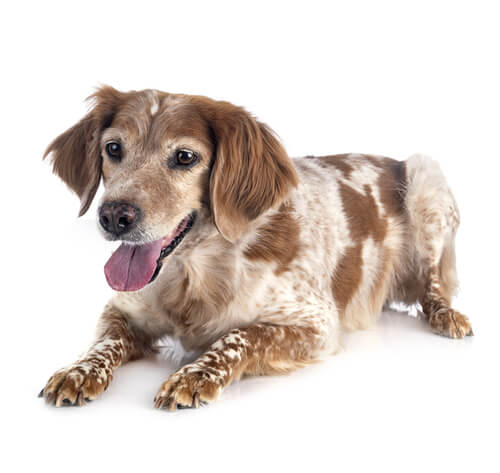
The Brittany is a hearty hunting dog skilled in pointing and retrieving game. Strong, quick, agile and alert, the Brittany is good-natured and friendly, making him a loving companion. The breed has a dense, feathered coat that protects him in the field and requires regular grooming. This energetic breed needs vigorous daily exercise and thrives with an active outdoor family.
DID YOU KNOW? The Brittany originated in the French province of Brittany, where the breed was first shown in 1896. Paintings by Jean-Baptiste Oudry from the early 1700s show a liver-and-white dog believed to be a Brittany pointing partridge.
ALSO KNOWN AS: Brittany Spaniel, Brittany Wiegref, Epagneul Breton
The need-to-know
- Dog suitable for experienced owners
- Extra training required
- Enjoys vigorous walks
- Enjoys walking more than two hours a day
- Medium dog
- Some drool
- Requires grooming every other day
- Non hypoallergenic breed
- Chatty and vocal dog
- Not a guard dog
- May require training to live with other pets
- Great family dog
Personality

Sociable and affectionate, the Brittany still retains a desire to hunt using sight and scent, and they are a busy, characterful dog with plenty of stamina and speed. Due to their sociable nature with people and other dogs, they make an excellent family dog with the right amount of exercise, training and entertainment, but this is not a dog to leave bored or unfulfilled!
History and Origins

Country of Origin: France
Previously known as the Brittany Spaniel, the Brittany’s origins lie in the pointers, setters and spaniels of Britain and France.In the Brittany region, the local spaniel and gundog types were mixed with the pointers and setters brought over by British landed gentry, who came for the snipe and partridge season and would leave their dogs in the care of French kennels from one season to the next. The offspring of these became the Brittany Spaniel, but with more influence from setters and pointers, they became longer in the leg and lost the long eared shorter legged spaniel look around the 19th Century.
Nutrition and Feeding

Your dog's diet needs to have the right balance of all the main nutrient groups including a constant supply of fresh water. It's also important to conduct regular?body condition?scores to ensure you keep your dog in ideal shape and remember to feed them at least twice daily and in accordance with the feeding guidelines of their particular food.
Exercise

The adult Brittany will need two hours or more per day to include walking, running, retrieving and finding hidden toys – this is a versatile and clever dog with enormous stamina! They need gainful employment in the form of training, games, puzzle solving and plenty of varied and amusing walks. Capable of doing well in a variety of canine sports and activities, from flyball to field trials, man-trailing to agility, the Brittany is a ‘do it all’ sort of dog.
Other Information

Health and common issues
As with many breeds, the Brittany dog (or 'Brittany Spaniel') can suffer from various hereditary eye disorders, and hip dysplasia (a condition that can lead to mobility problems). Eye testing and hip scoring of dogs prior to breeding is therefore important. Epilepsy also occasionally occurs in the breed. The breed club monitor the health of the breed carefully and should be contacted for the most up-to-date information and details of any DNA or additional testing they recommend. Breed Clubs can be found on the Kennel Club website.
Space requirements
This is not a large dog, but it is an active one, so a rural or suburban home with a large secure garden and plenty of space for training and games is important. Access to a variety of interesting walks where they can follow scent, and secure locations to allow them to run, quarter and play will suit them well. Unlikely to do well in a busy city or town environment.
Training brittany dogs
The Brittany will respond to reward-based training and it is not hard to find things to reward them with. Food goes down well as will retrieval games, scent-based games involving finding hidden toys or even hidden people (man-trailing) as the Brittany will be happy as long as they are engaged, with their person, in some task or other. Do not leave a Brittany bored however as they don’t fare well left to amuse themselves and nor will your home or furniture! Pay attention to recall and work hard at teaching them to give, drop or swap items as this breed likes to retrieve and carry objects in their mouth.
Best family dog breeds
With an active, dog-savvy family the Brittany makes a great companion, however they are not suited to sitting around all day and will struggle with a very busy or loud family of small children as that can over-stimulate their sensitive personalities. Older children and teenagers may enjoy being involved in training and exercise with this fun and willing dog. While many dogs are traditionally thought of as being good with children, all dogs and children need to be taught to get on with and respect each other, and be safe together. Even so, dogs and young children should never be left alone together and adults should supervise all interactions between them.
Did you know?
- Brittany’s can be long tailed or can have a natural stubby tail; -or sometimes even be born totally tailless.
- Brittany’s are known to become very attached to their owners and are prone to developing separation anxiety, so this isn’t a suitable breed if you spend a lot of time out the house.
- Brittany type dogs can be traced back to tapestries and paintings from the 17th century.
- The Brittany gets its name from the French Province it comes from.
- It’s thought that Brittany’s and Welsh Springer Spaniels are closely related and share the same ancestors.